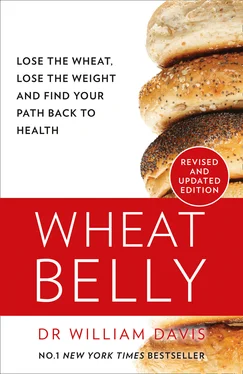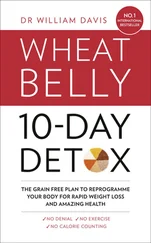In effect, wheat is an appetite stimulant : It makes you want more—more cookies, cupcakes, pretzels, candy, soft drinks. More bagels, muffins, tacos, submarine sandwiches, pizza. It makes you want both wheat-containing and non-wheat-containing foods. And, on top of that, for some people wheat is a drug, or at least yields peculiar drug-like neurological effects that can be reversed with medications used to counter the effects of narcotics.
If you balk at the notion of being dosed with a drug such as naloxone, you might ask, “What happens if, rather than blocking the brain effect of wheat chemically, you simply remove wheat altogether?” Well, that’s the very same question I have been asking. Provided you can tolerate the withdrawal (while unpleasant, the withdrawal syndrome is generally harmless aside from the rancor you incur from your irritated spouse, friends, and co-workers), hunger and cravings diminish, caloric intake decreases, mood and well-being increase, weight goes down, wheat belly shrinks.
Understanding that wheat, specifically exorphins from gluten, have the potential to generate euphoria, addictive behavior, and appetite stimulation means that we have a potential means of taking back control over eating habits and weight: Lose the wheat and lose the weight, as well as the myriad effects this never-should-have-been-food-in-the-first-place thing has over us.
CHAPTER 5
YOUR WHEAT BELLY IS SHOWING: THE WHEAT/OBESITY CONNECTION
PERHAPS YOU’VE EXPERIENCED this scenario:
You encounter a friend you haven’t seen in some time and exclaim with delight: “Elizabeth! When are you due?”
Elizabeth: [Pause.] “Due? I’m not sure what you mean.”
You: Gulp …
Yes, indeed. Wheat belly’s abdominal fat can do a darn good imitation of a baby bump.
Why does wheat cause fat accumulation specifically in the abdomen and not, say, on the scalp, left ear, or backside? And, beyond the occasional “I’m not pregnant” mishap, why does it matter?
And why would elimination of wheat lead to loss of abdominal fat?
Let’s explore the unique features of the wheat belly–body configuration.
WHEAT BELLY, LOVE HANDLES, MAN BOOBS, AND “FOOD BABIES”
These are the curious manifestations of consuming the modern grain we call wheat. Dimpled or smooth, hairy or hairless, tense or flaccid, wheat bellies come in as many shapes, colors, and sizes as there are humans. But all share the same underlying metabolic cause.
I’d like to make the case that foods produced with or containing wheat make you fat. I’d go as far as saying that overly enthusiastic wheat consumption is the main cause of the obesity and diabetes crisis in the United States. It’s a big part of the reason why Jillian Michaels needed to badger The Biggest Loser contestants. It explains why modern athletes, such as baseball players and triathletes, are fatter than ever, and why the most popular dress sizes are now 16 to 18. Blame wheat when you are being crushed in your airline seat by the 280-pound man next to you.
Sure, sugary soft drinks and sedentary lifestyles add to the problem. But for the great majority of health-conscious people who don’t indulge in these obvious weight-gaining behaviors, the principal trigger for increasing weight is wheat.
In fact, the incredible financial bonanza that the proliferation of wheat in the American diet has created for the food and drug industries can make you wonder if this “perfect storm” was somehow man-made. Did a group of powerful men convene a secret Howard Hughesian meeting in 1955, map out an evil plan to mass-produce high-yield, low-cost semi-dwarf wheat, engineer the release of government-sanctioned advice to eat plenty of “healthy whole grains,” lead the charge of corporate Big Food to sell hundreds of billions of dollars worth of processed wheat food products—all leading to obesity and the “need” for billions of dollars of drug treatments for diabetes, heart disease, and all the other health consequences? It may sound ridiculous, but in a sense that’s exactly what happened. Here’s how.
WHEAT BELLY DIVA
Celeste no longer felt “cool.”
At age sixty-one, Celeste reported that she’d gradually gained weight from her normal range of 120 to 135 pounds in her twenties and thirties. Something happened starting in her mid-forties, and even without substantial changes in habits, she gradually ballooned up to 182 pounds. “This is the heaviest I have ever been,” she groaned.
As a professor of modern art, Celeste hung around with a fairly urbane crowd. Her weight made her feel self-conscious and out of place. So I got an attentive ear when I explained my diet approach that involved elimination of all wheat products.
Over the first three months she lost 21 pounds, more than enough to convince her that the program worked. She was already having to reach into the back of her closet to find clothes she hadn’t been able to wear for the past five years.
Celeste stuck to the lifestyle, admitting to me that it had quickly become second nature, with no cravings, a rare need to snack, just a comfortable cruise through meals that kept her satisfied. She noted that, from time to time, work pressures kept her from being able to have lunch or dinner, but the prolonged periods without something to eat proved effortless. I reminded her that healthy snacks such as raw nuts, flaxseed crackers, and cheese readily fit into her program. But she simply found that snacks weren’t necessary most of the time.
Fourteen months after adopting the Wheat Belly lifestyle, Celeste couldn’t stop smiling when she returned to my office at 127 pounds—a weight she’d last seen in her thirties. She’d lost 55 pounds from her high, including 12 inches off her waist, which shrank from 39 inches to 27. Not only could she fit into size 6 dresses again, she no longer felt uncomfortable mingling with the artsy set. No more need to conceal her sagging wheat belly under loose-fitting tops or layers. She could wear her tightest Oscar de la Renta cocktail dress proudly, no wheat belly bulge in sight.
WHOLE GRAINS, HALF-TRUTHS
In nutrition circles, whole grains are the dietary darling du jour. In fact, this USDA-endorsed, “heart healthy” ingredient, the stuff that purveyors of dietary advice agree you should eat more of, even dominate diet, makes us hungry and fat, hungrier and fatter than any other time in human history.
Hold up a current picture of ten random Americans against a picture of ten Americans from the early twentieth or preceding century, and you’ll see the stark contrast: Americans are now fat. According to the CDC, 39.6 percent of adults are obese (BMI 30 or greater), another 36 percent are overweight (BMI of 25 to 29.9), leaving only one in four at normal weight. Since 1960, the ranks of the obese have grown the most rapidly, nearly tripling over those sixty years. 1
Few Americans were overweight or obese during the first two centuries of the nation’s history. (Most actual data collected on BMI that we have for comparison prior to the twentieth century come from body weight and height tabulated by the U.S. military. The average male in the military in the late nineteenth century had a BMI of <23.2, regardless of age; by the 1990s, the average military BMI was well into the overweight range. 2We can easily presume that, if it applies to military recruits, it’s worse in the civilian population.) Weight grew at the fastest pace once the USDA and others got into the business of telling Americans what to eat. Accordingly, while obesity grew gradually from 1960, the real upward acceleration of obesity started in the mid-eighties.
Studies conducted during the eighties and since have shown that, when processed white flour products are replaced with whole grain flour products, there is a reduction in colon cancer, heart disease, type 2 diabetes, and less weight is gained. All that is indeed true, an indisputable half-truth.
Читать дальше












